When a customer messages your business, they expect a fast and helpful reply, whether it’s through chat, email, or social media. Waiting around for answers isn’t something most customers tolerate anymore.
That’s where AI in customer communication comes in.
This practice refers to using artificial intelligence tools to keep interactions flowing smoothly while assisting support teams. From chatbots and voice assistants to tools that suggest responses or analyze messages, AI is becoming a key part of how businesses communicate.
And it’s making a difference. According to our own study, 73% of customers believe AI can improve their customer experience, highlighting the growing trust in AI-driven communication tools.
In this article, we’ll explore the benefits of AI in customer communication. We’ll also delve into practical use cases and share best practices to successfully integrate AI into your customer service strategy.
Streamline customer communication with Lyro AI Agent
How do customers feel about AI?
Chatbots are a common part of support experiences, but the feedback is still mixed in some areas.
According to our research, customers most often turn to chatbots for tasks like technical support, billing questions, and basic product information. These are frequent, repetitive requests that are a natural fit for AI.
When it comes to how people feel about AI support, 75% of users said they were satisfied with their most recent chatbot interaction. Moreover, for 70% of them, the chatbot fully resolved the issue. That said, about 30% would still rather wait for a human, and more than 11% said they’d pay to bypass the bot entirely.
These results highlight the areas where AI is already helping with communication and where there’s still room to improve, not because the technology isn’t capable, but because of how it’s implemented.
Read more: Find out more about what people really think about customer service chatbots in our study.
Types of AI in customer communication
Different tools are doing different jobs behind the scenes, and understanding what each one does makes it easier to choose the right setup for your team.
Here’s a quick overview of the most common types of AI in customer communications you’ll come across.
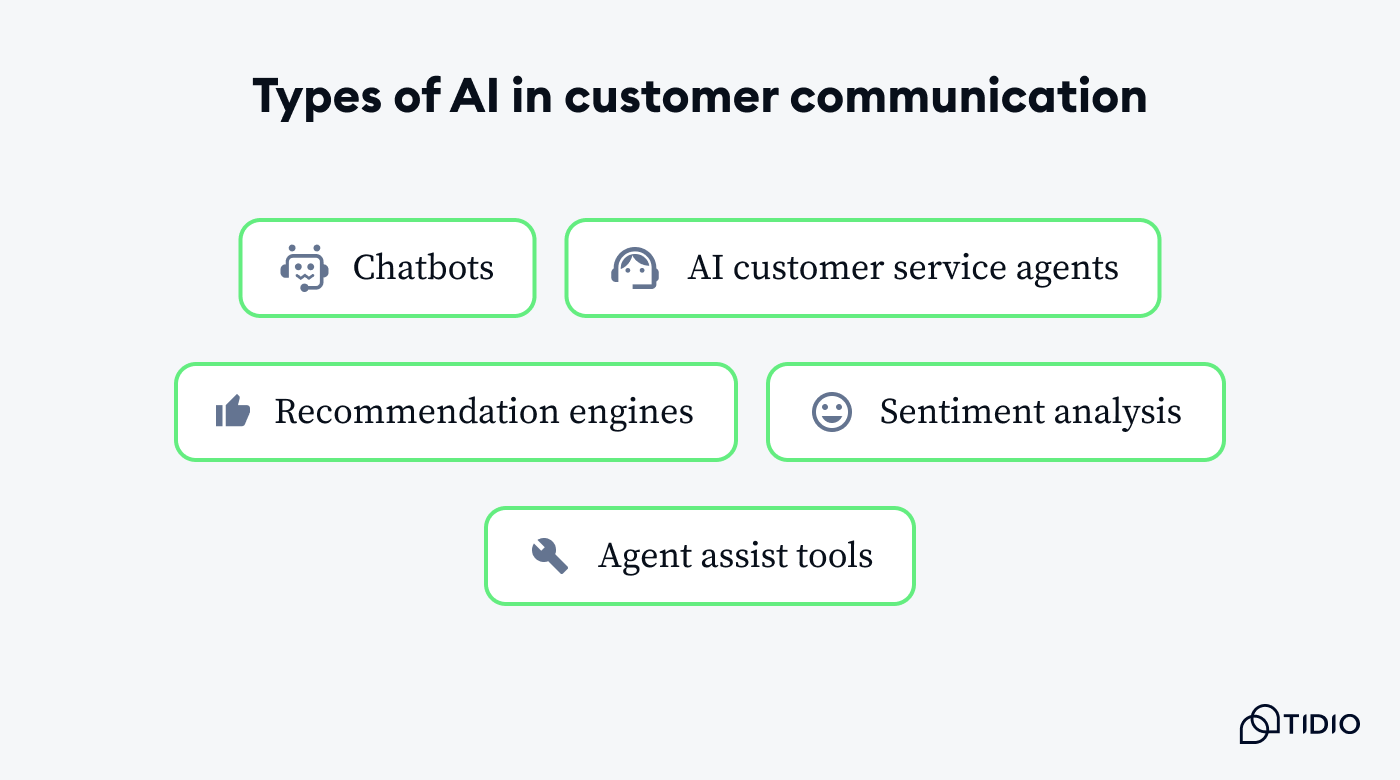
- Chatbots: Used to answer common questions, guide users through simple steps, or help with tasks like order tracking and password resets. Usually, they’re the first point of contact on your website or in live chat.
- AI customer service agents: More advanced than basic bots. They can understand questions in natural language, follow up based on previous messages, and resolve more complex issues without needing a human right away. Lyro AI Agent is a great example.
- Recommendation engines: Helpful in ecommerce or support portals. These suggest products, articles, or next steps based on the customer’s behavior or past activity.
- Sentiment analysis: Looks at tone and phrasing to figure out how a customer feels. This helps with prioritizing tickets or deciding when a conversation should be escalated to a human agent.
- Agent assist tools: Suggest replies or summarize conversation history so agents don’t have to dig through everything manually. Tidio’s Copilot is a good example as it works alongside agents during live chats, offering real-time support without interrupting the flow of the conversation.
Read more: Find out all you should know about AI copilots for customer service.
Key use cases: how businesses apply AI in communication
When support teams get flooded with questions, AI tools help keep things on track. They step in to handle common requests and give agents room to focus on more complex tasks.
Let’s check out some of the well-known use cases of AI in customer communications:
Smart agents and automation
Support teams often get stuck answering the same basic questions over and over. AI chatbots take some of that load off by responding to common queries instantly, directing customers to the right resources, or guiding them through simple workflows like order updates or troubleshooting steps.
Cove Smart, a fast-growing DIY home security company in the US, faced exactly that kind of challenge. Their support team was buried in copy-pasted responses and couldn’t keep up with tickets across multiple products and systems. After switching to Tidio and activating Lyro AI Agent, they saw a clear difference. Response times dropped by 80%, resolution rates went up by 70%, and overall customer satisfaction climbed by 35%.
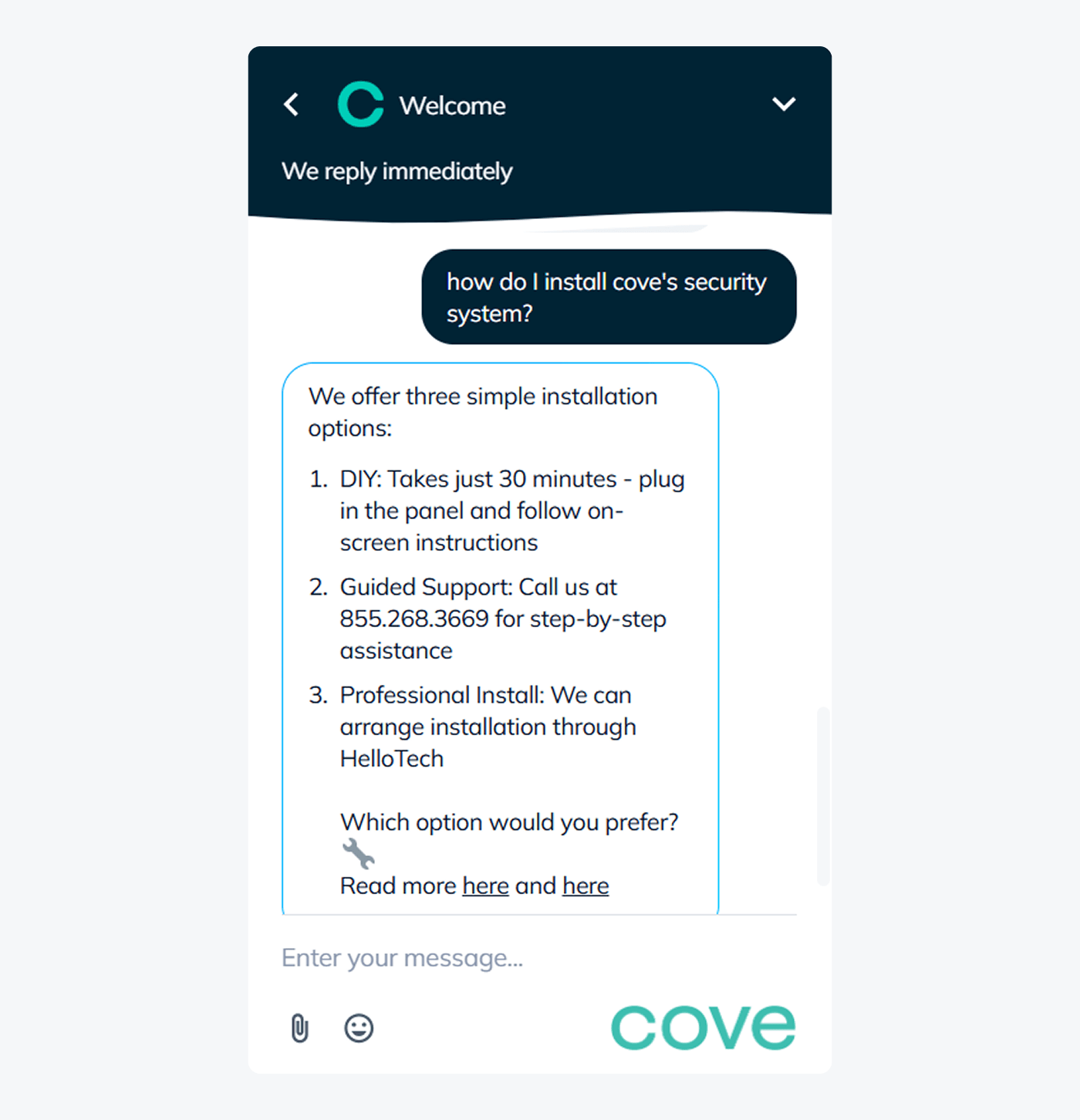
Lyro now handles thousands of monthly inquiries for them, helping customers troubleshoot hardware-specific issues and navigate different generations of their products.
Read more: Learn more in our Cove Smart case study.
See how Lyro improves support and keeps conversations on track
Real-time assistance for agents
When agents are handling multiple chats at once or trying to juggle complex requests, every second counts. AI copilots step in to lighten that load. They do this by suggesting replies and handling the repetitive work that slows people down.
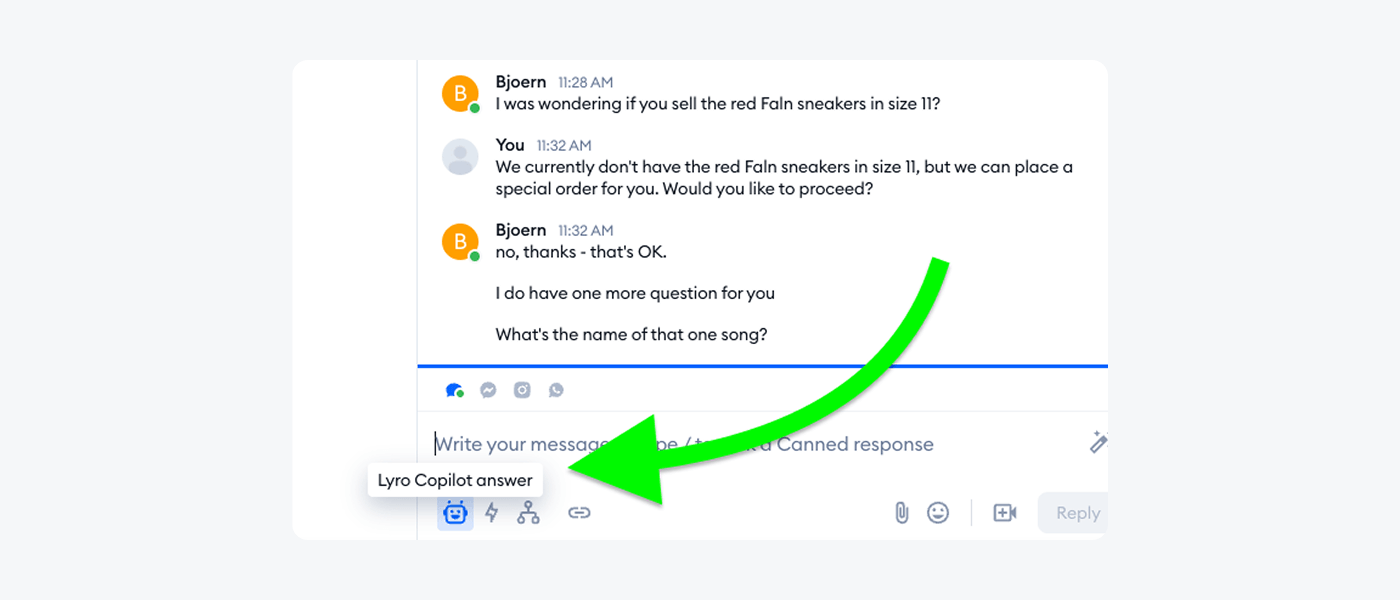
Instead of switching tabs or hunting through documentation, agents get the context they need right in the conversation window. This kind of instant support helps teams stay focused and move faster, especially when queues start to grow. It also makes onboarding easier, since even newer agents have a bit of backup when they’re still learning the ropes.
Personalization
Every customer wants to feel like they’re getting more than just a generic reply. AI can help make that happen without slowing your team down. By analyzing conversation history, behavior, and preferences, AI agents adjust replies to match better what each person is looking for.
Lyro AI Agent is a good example of this in action. It draws from your connected data to suggest helpful, on-brand replies. When integrated with Shopify, it can also recommend products in real time. The product recommendation feature allows the AI to act like a virtual shopping assistant, offering suggestions based on what the customer is asking or browsing. What’s especially noteworthy is that Lyro understands the intent behind a message and uses real data to respond.
Take Cones Only, for instance. This company uses Lyro to guide visitors toward the right product without any extra effort on the customer’s part. Whether someone’s planning a birthday party or looking for a specific cone flavor, Lyro offers suggestions directly in the chat, complete with links to the product page.

Read more: Find out how to build a product recommendation chatbot in no time. Also, be sure to check out Product Recommendations in Lyro.
Sentiment analysis and prioritization
Some messages just need more attention. Whether it’s an upset tone or a time-sensitive request, AI can pick up on these cues and help teams respond faster. By detecting sentiment and urgency, AI makes it easier to flag conversations that shouldn’t wait at the end of the queue.
Lyro AI Agent supports this by escalating tricky or emotionally charged conversations to human agents, without losing any context. That way, customers aren’t stuck explaining things twice, and agents can jump in with the full picture. It keeps things moving and shows customers they’re being taken seriously.
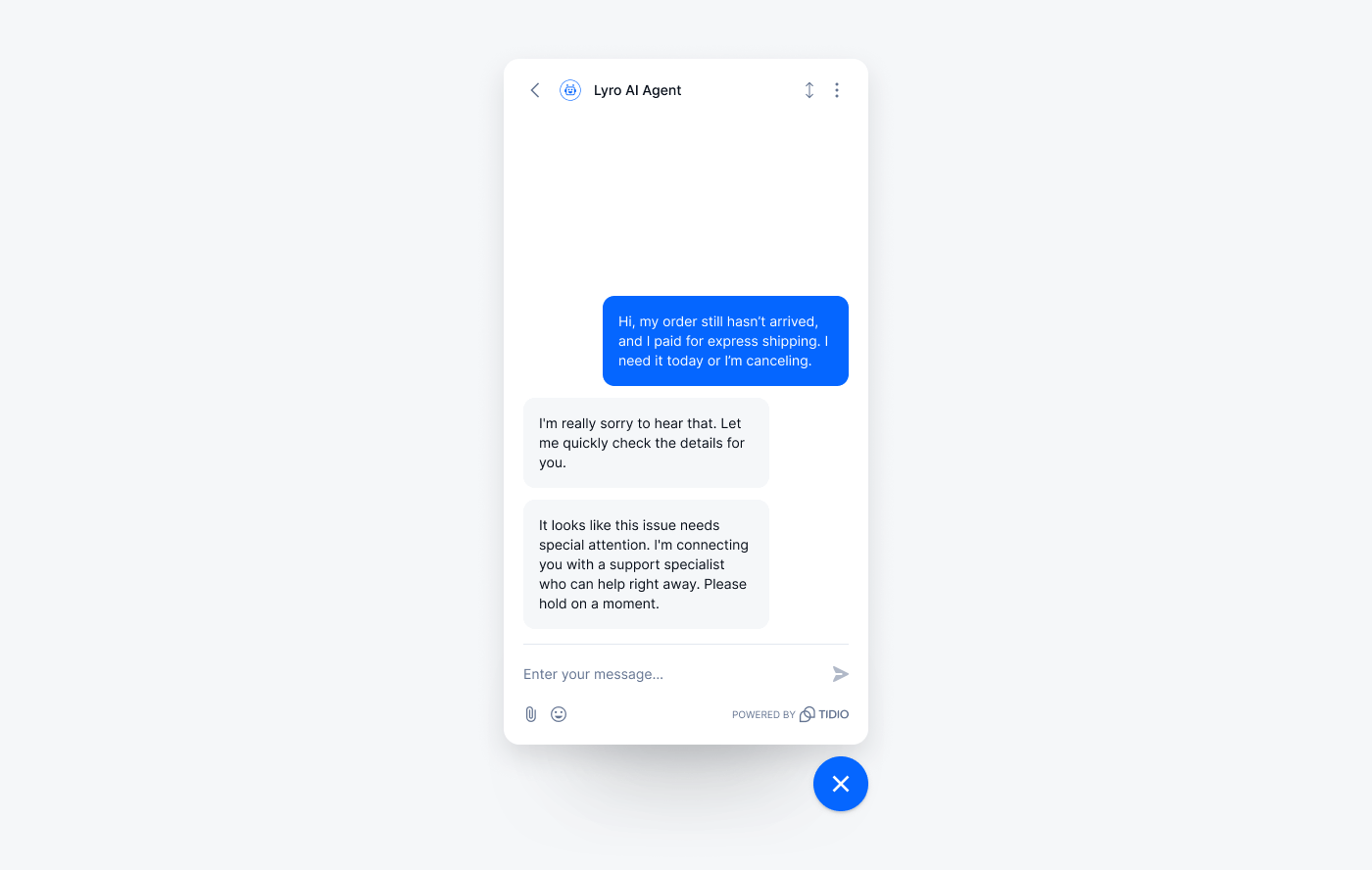
Benefits of using AI in customer communication
There are many ways in which AI is changing how support teams handle everyday conversations. Apart from speeding up replies, it keeps messaging clear and consistent, helping agents manage their workload without getting overwhelmed.
Here’s what AI brings to the table in more detail:
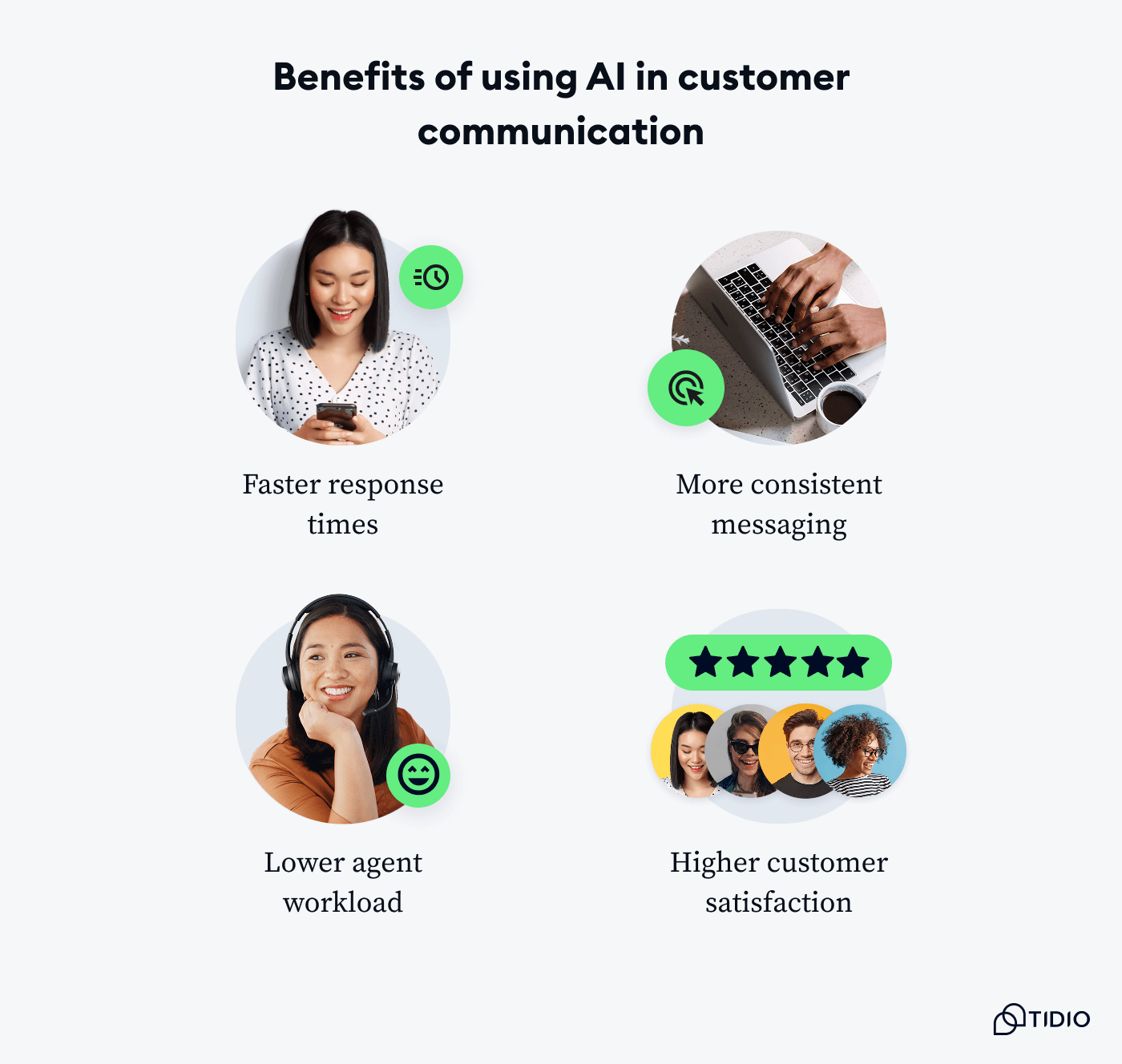
- Faster response times: Companies using AI have experienced a 37% drop in first response times and as much as a 52% decrease in ticket resolution times.
- More consistent messaging: AI keeps replies aligned with the company tone and reduces the risk of human error. Tools that provide suggested responses help teams deliver more uniform communication, even when multiple agents are involved.
- Lower agent workload: AI reduces the volume of repetitive tasks, allowing agents to focus on complex issues. In fact, 70% of customer service agents report a reduction in overall workload through the use of generative AI and agentic AI technologies.
- Higher customer satisfaction: According to our AI customer service statistics, 80% of customers who interacted with AI-driven customer service reported a positive experience.
Challenges of using AI in customer communication
Even with all the benefits, using AI in support isn’t always smooth from day one. Here are a few common issues that come up, and how your team can work around them.
Customers feel like they’re stuck talking to a bot
One of the biggest complaints is not being able to reach a real person. If the AI keeps looping or offers vague answers, trust goes out the window.
Solution: Make handoffs easy. Set clear conditions for when a human steps in, and give customers an obvious way to ask for one.
The AI pulls outdated or unclear information
If your help center hasn’t been updated in a while, the bot will reflect that. This leads to wrong answers or replies that feel out of touch.
Solution: Keep your knowledge base in shape. Audit articles regularly and make sure your chatbot is pulling from the right content.
It’s not clear what the AI can or can’t do
When expectations aren’t set, customers either overestimate the bot or get frustrated trying to guess what it’s for.
Solution: Add a short intro message that explains what the bot is here to help with. A little clarity up front makes the whole interaction feel smoother.
Read more: Here are effective techniques that will help you deal with angry customers.
Best practices for using AI in customer communication
To get real value from using AI, you need to approach it the way you would any other tool that supports your team: thoughtfully, with clear goals and regular check-ins. Start small, focus on the areas where it can make a noticeable difference, and treat it like part of the team, not a magic fix.
The practices below can make all the difference.
Start with one workflow
It’s easier to see results when you begin with a single, high-impact use case. Order tracking, return requests, or common FAQs are great starting points because they usually follow a clear structure. Once you’ve seen how AI performs in one area, you’ll have more confidence about where to go next.
Regularly review and improve your help center
Set a regular schedule to check which articles need updates or where customers tend to drop off. Use chat transcripts or analytics to spot patterns. A well-maintained help center means better answers from your AI and less work for your team.
Combine automation with human judgment
Even the best AI won’t replace the need for a human touch. There should always be a way for customers to reach an agent, especially when things get complicated.
It also helps to be clear about who’s answering. Let people know when they’re chatting with AI. A simple message like “Hi, I’m a virtual assistant here to help” sets expectations and keeps the experience transparent.
Track what matters
Don’t get caught up in vanity metrics. Focus on what actually reflects customer experience, like resolution rate and handoff rates. These numbers will show you where your AI is helping and where it might need a little fine-tuning.
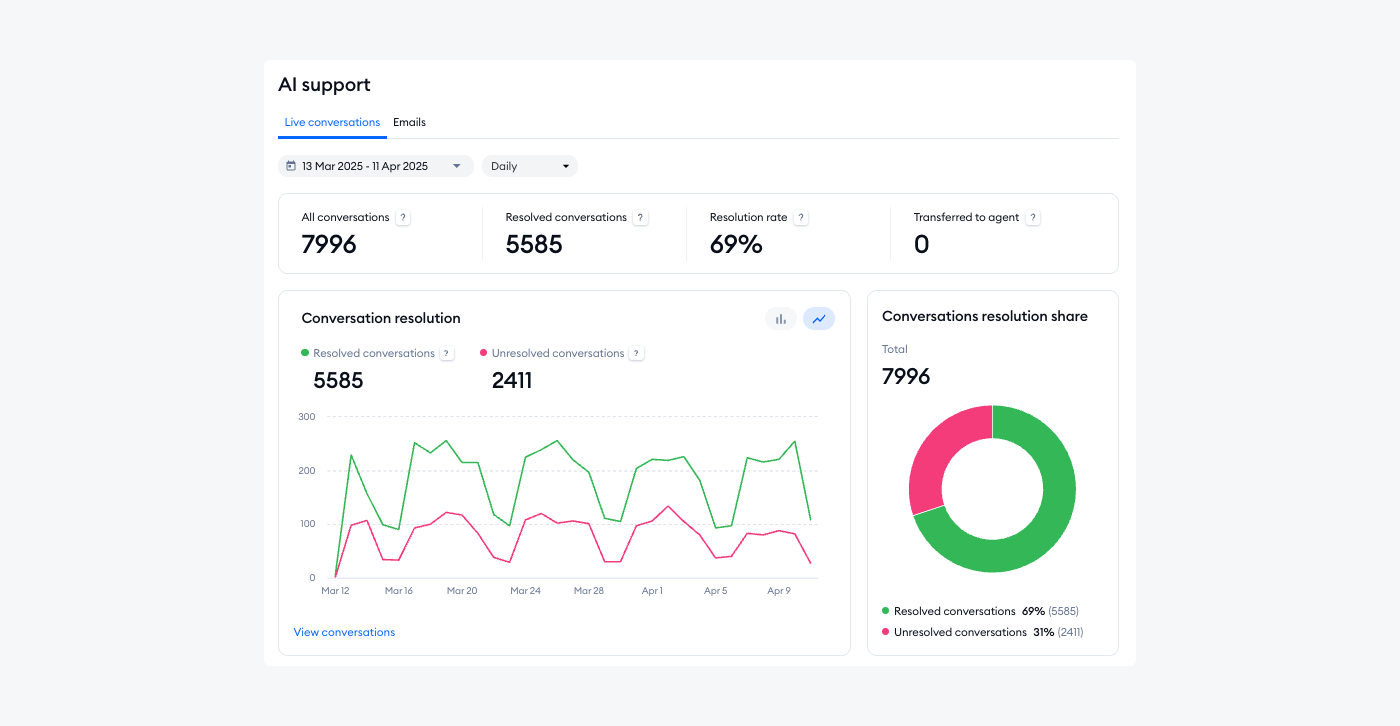
Look at where customers are getting stuck, which responses they find helpful, and when agents have to step in. You can use this data to refine both your automated flows and your support team’s approach. The more you learn, the more helpful your AI becomes.
Read more: Explore the key customer service metrics you should keep track of. Also, check out real-life examples of what AI customer service can do for your business
Try Lyro AI and enhance customer communication today
Lyro gives your team space to focus while still helping customers get quick, accurate answers. It works quietly in the background, handling repetitive questions and staying aligned with your support goals. Moreover, you can connect it with your existing tools and get it running without adding extra complexity.
If you’re looking for a way to manage support conversations more smoothly, this AI customer communication tool is a practical place to start. Start your free trial as soon as today and see how Lyro fits into your support flow.
See how Lyro improves support and keeps conversations on track
FAQs
AI can automate repetitive queries, route tickets, suggest responses, and even handle full conversations using natural language understanding. It helps teams scale support without hiring more agents, while improving speed and consistency all at once.
AI enables real-time responses and message personalization across chat, email, and voice channels. It powers everything from chatbots and virtual assistants to conversational tools that can adapt tone and keep conversations on track.
The best AI tool depends on your business needs. For small to medium businesses, and even those planning to expand, Tidio’s Lyro AI agent is a standout option. On top of being easy to set up, it also learns from your help center content and works instantly across chat channels.
Tidio is a customer communication platform that combines live chat, AI automation, and help desk features. It helps businesses support and convert customers across different channels, including website chat, Messenger, email, and more.
Tidio streamlines customer support by centralizing conversations across multiple channels. It includes live chat, ticketing, and AI-powered agents like Lyro.
Tidio shortens resolution times and reduces the number of support tickets. With its AI agent Lyro automating around 67% of questions, teams can save hours weekly while improving customer satisfaction.

